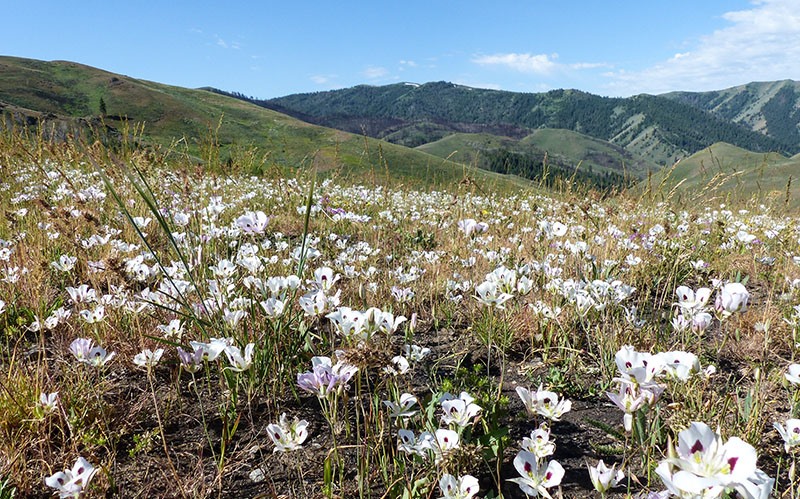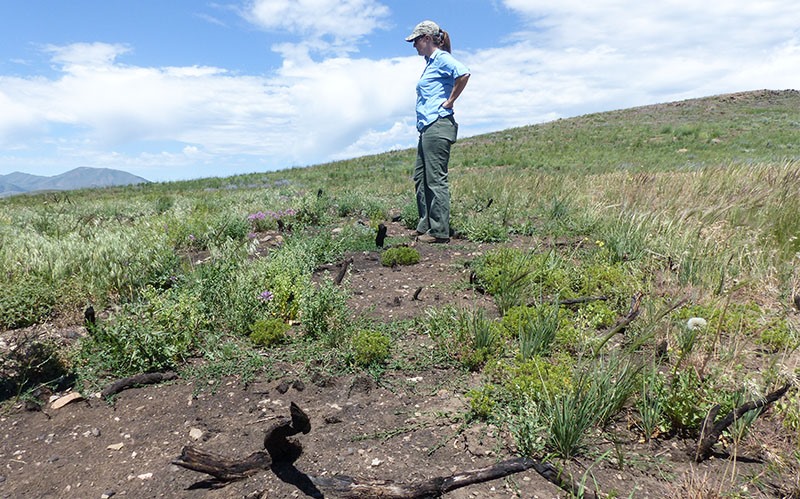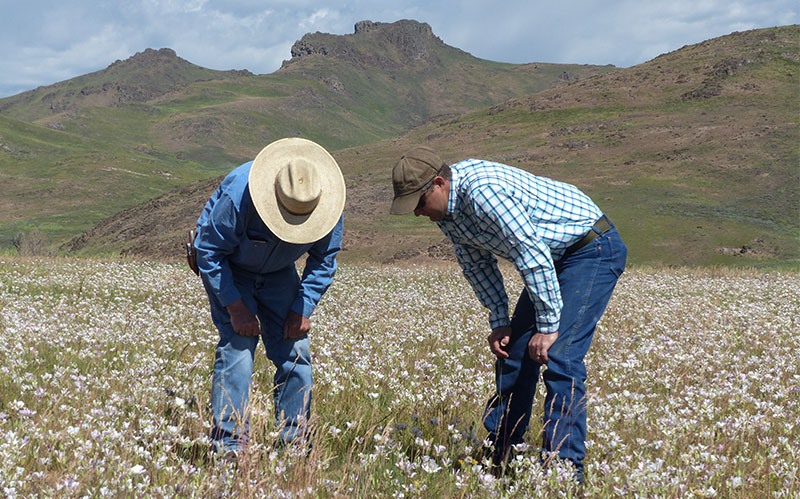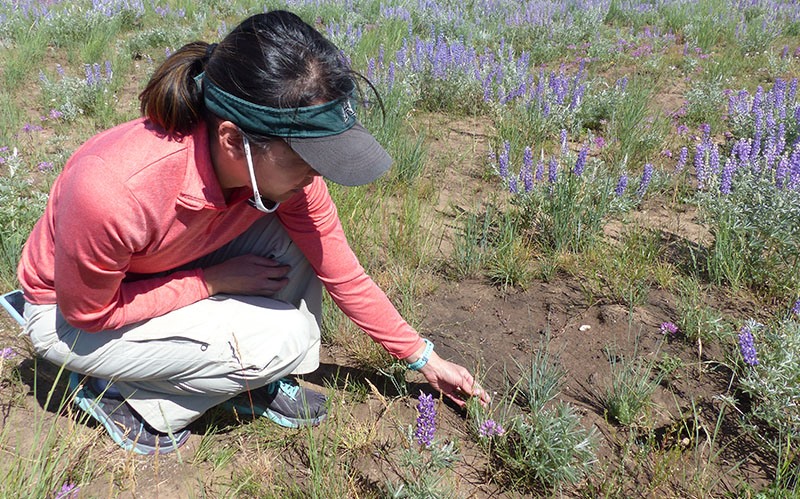|
STORY AND PHOTOS BY KAREN BOSSICK Rebecca Patton marveled as she looked out over a field of sego lilies so thick it looked like snow on the fields that she and her husband Tom had let cattle graze until last August’s Sharps Fire turned it black. “This was covered with sagebrush that must’ve been at last 50 years old,” she said as she looked around their Little Wood Ranch. “Now look at it.” “It looks beautiful, but it’s important to note there’s still a lot of bare soil,” cautioned Bobbi Filbert, wildlife biologist for the Sawtooth National Forest. “Right now, it’s a mosaic of new plants and burned area. It’ll take a while for the grasses to return.”
|
|

Sego lilies cover a hillside with a view to burnt forest lands overlooking Sharp Canyon.
|
|
|
It was nearly a year ago that a Bellevue man shooting explosive targets set off a wildfire in Muldoon Canyon. The fire rampaged over 65,000 acres, threatened homes and livestock, closed popular Forest Service campgrounds and sent a thick shroud of smoke over the Wood River Valley. Eleven months later, representatives of The Nature Conservancy, Wood River Land Trust, Bureau of Land Management, Idaho Fish and Game, Sawtooth National Forest and other agencies traveled across the area, meeting with property owners to see what effects fall seeding had had and what areas of concern remain. “Sego lilies were not in the mix,” said Charlie Sandford, wildlife biologist with U.S. Fish and Wildlife. He scooped up a handful of soil, blowing the ash off his fingers.
|
|

Cameron Packer, development director for the Wood River Land Trust, checks out the vegetation that has sprung up amidst charred remnants of sagebrush and other plants.
|
|
|
“A lot of times, fires cook and sterilize soil, killing the seeds. This was one intense fire but it looks like it may have only burnt an inch below the surface. So, suddenly, the seeds there had all their competition removed. The lupine said, ‘Now’s my time,’ and popped up.” Flat Top rancher John Peavey was quick to tell the group as they assembled in Bellevue that “old-timers say you’ve never seen pretty until you’ve seen Muldoon in spring.” But this trip out the canyon east of Bellevue would exceed even anything he’d ever seen before the day was out. As the entourage headed towards the top of Muldoon Summit, Peavey surveyed vast hillsides that had been blackened when he took the same drive last fall.
|
|

John Peavey and Dan Patten check to see what kinds of grasses and forbs are growing amidst the sego lilies.
|
|
|
This time a newly cut road angled up a hillside above Sharps Canyon where the fire had started. At the end sat a logging truck full of fire-damaged logs against a backdrop of charred trees. At the top of Muldoon Summit, The Nature Conservancy’s Tess O’Sullivan stopped to point out an area that had been burned in the Martin Fire in 2017. It, too, had been started by someone target shooting. And it, too, had been seeded from the air. “It’s important sagegrouse habitat,” she said. The group got back in their vehicles and Peavey pointed his black GMC pickup down the dirt road on the other side.
|
|

Lisa Eller, director of communication for The Nature Conservancy, scrutinizes patchy stands of grass amidst the lupine and onion flowers.
|
|
|
“The fire got the old Patriarch Tree,” he said, pointing out a huge Douglas fir that had witnessed the comings and goings of ranchers and miners for hundreds of years. But, Peavey noted, green aspen shoots were emerging amidst blackened aspen and willow. Hillsides that had been black last fall were now green speckled with lavender lupine, the magenta-colored flowers of onion plants and purple penstemon. Yellow mules ear daisies hung out along Cold Springs. And yellow buckwheat anchored the dust in other places, keeping it from blowing away in the wind. “For this not to be a full year this is not what we would have expected,” said Filbert, gazing around the bountiful display of wildflowers.
“With the cool wet spring this year, we got a second shot. Some plants are putting on seed, which is not typical in the first year after a fire,” added Danelle Nance, fire ecologist for the BLM. “But it will still be awhile before this area can be grazed again.” Peavey continued to make his way down the road. “See that post over there,” he pointed to a charred post two feet tall. “That was a telephone pole put in 80 years ago. Single wire. You had to crank the phone.” Near the bottom of Cold Springs Peavey passed corrals that his father had built and drove his pickup across the Little Wood River.
“This is where we put 200 of our cows, hoping it wouldn’t burn. We had to round up half of them the next day after they strayed.” The agencies partnered with landowners to seed more than 600 acres on some south slopes by air, using a plane that flew just a hundred feet above the ground. They seeded other areas using a beefy drill pulled by a tractor that rolled over rocks, depositing seeds two inches deep. The seed mix included Great Basin wildrye, mountain big sagebrush, bluebunch wheatgrass, alfalfa, small burnet and yellow blossom sweet clover. “I’ve seen very little cheatgrass with the exception of the south slopes,” said Sandford. “That’s a good sign—it means these plants will have a year to outpace cheatgrass.”
But seeding was limited by difficulty of terrain and limited money, despite contributions by REI. One area fire ecologists were not able to seed was Thompson Creek area where Lava Lake Lamb Rancher Brian Bean grazes his sheep. The fire raced along steep hillsides, nearly taking out some of the homes in the vicinity of Muldoon Ranch before it came to a stop at Muldoon Creek. But it burned especially hot in the Thompson Creek area, as it had along Cold Springs and High Five. Bean led the group across a bridge and up a cat track where firefighters had made a stand. A few purple monkeyflowers peaked out among the shale. But the bulk of the new growth was what Bean was told was Japanese brome, an invasive grass similar to cheatgrass that has poor forage quality.
Cheatgrass could be seen on the steep hillsides above. “Can anything be done now?” asked Bean, hoping to prevent the spread of an invasive plant that is quick to burn and crowds out more useful native plants. The area had been too steep and rocky to seed with a drill and too sensitive an area to seed by air due to the proximity of the creeks, he was told. Nance ventured that there was probably an equal mixture of native forbs and brome and that she expected the percentage of forbs to increase.
“Let’s wait and see,” she said, adding that hand planting would probably be the best measure Bean could take if he wanted to do something. The Nature Conservancy and other groups have developed more than a hundred beaver mimicry structures over five miles of creeks in the Sharps Fire area. This year they hope to do the same along another five miles of creeks, including Thompson Creek, to increase water flow, soil stability and the water table in those areas, said O’Sullivan, conservation manager for The Nature Conservancy. Beavers that have been causing problems elsewhere may be trapped and brought to a place like Thompson Creek, in hopes that they will continue the work that the human dam builders started, she added. Two-legged critters known as humans have been causing the problems in the Sharps Fire area, driving off-road vehicle in areas where the fire burned vegetation, noted Flat Top rancher Tom Peavey.
“ATVs running up the hills. Water rolling down their tracks, eroding the area,” he said. “I have to close my eyes and shake my head.”
|